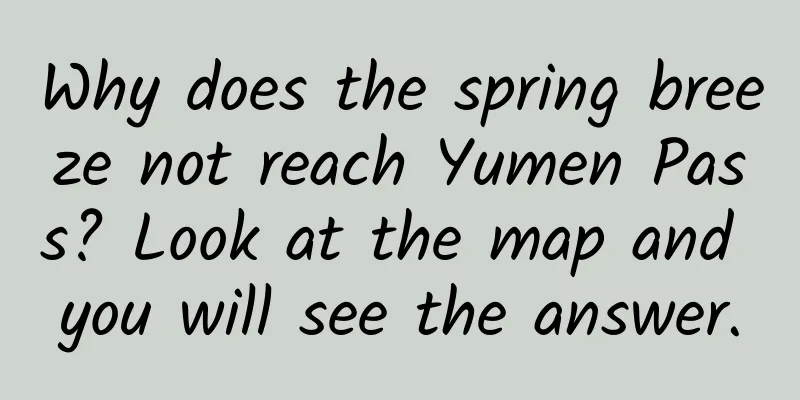Why does the spring breeze not reach Yumen Pass? Look at the map and you will see the answer.

|
"The Yellow River flows far away among the white clouds, and there is a lonely city on the ten thousand feet mountain. Why should the Qiang flute blame the willows, the spring breeze does not reach Yumen Pass." This poem "Liangzhou Ci" by Wang Zhihuan, a poet of the Tang Dynasty, expresses the desolation outside the Great Wall and the homesickness of the soldiers guarding the border. Why did the poet say "the spring breeze does not reach Yumen Pass"? Let's talk about Yumen Pass today. There are many poems related to Yumen Pass, such as "Respectfully Reciting Zuo Gong's Journey to Gantang" by Yang Changjun of the Qing Dynasty: "The general has not yet returned from the border, and the young men of Hunan and Xiang are all over Tianshan. Newly planted willows for three thousand miles, attracting the spring breeze to cross Yumen Pass." This poem describes the scene of Zuo Zongtang carrying his coffin to the expedition and recovering Xinjiang in the late Qing Dynasty. Zuo Gong led his soldiers to plant hundreds of thousands of willow trees on the way to the west, and later generations called them "Zuo Gong Willows". "Attracting the spring breeze to cross Yumen Pass", the poet linked the spring breeze with Yumen Pass again. Where is Yumen Pass? Among the counties and cities under the jurisdiction of Jiuquan City, Gansu Province, there are two county-level cities, Yumen City and Dunhuang City. Yumen Pass is not in Yumen City, but in Dunhuang City. Dunhuang City has a large area of about 31,200 square kilometers and a population of about 185,000. The terrain is high in the north and south and low in the middle, sloping from southwest to northeast, with an average altitude of 1,139 meters. Dunhuang has a long history. During the reign of Emperor Wu of the Han Dynasty, Huo Qubing and others were sent to lead an army to the west to drive out the Xiongnu, open up the Hexi Corridor, and set up the Four Hexi Commanderies, namely Wuwei, Jiuquan, Zhangye, and Dunhuang. Dunhuang is the westernmost of the Four Hexi Commanderies. During the Eastern Han Dynasty, a deputy envoy of the Protectorate General of the Western Regions was stationed in Dunhuang to manage the Western Regions for the court. The Hexi Corridor is a geographical passage that runs from Wushaoling in the east to Xingxingxia in the west, across central Gansu, about 1,200 kilometers long and several kilometers to more than 100 kilometers wide. The Hexi Corridor was the link and only way for the ancient Central Plains to connect with the Western Regions, and it has great significance and played a very important role in the development of the Chinese nation. When the Han Dynasty established the four counties in Hexi, it also built the Han Great Wall and border defenses and fortresses such as Yumen Pass and Yangguan Pass. Outside the pass is the vast Western Desert. Yumen Pass is located about 90 kilometers northwest of Dunhuang City, about 150 kilometers to the west is Lop Nur and the Taklimakan Desert, to the north is the old course of the Shule River, and to the south is the Hara Lake. Yumen Pass guards the western end of the Hexi Corridor and is the gateway from the Central Plains to the Western Regions. After the Silk Road was opened, merchants traveled back and forth constantly, and the beautiful jade from Khotan (now Hotan, Xinjiang) in the Western Regions entered the Central Plains through this pass, hence the name Yumen Pass. Today, only the ruins of Yumen Pass remain, called the Xiaofangpancheng Ruins. The castle is square in plan, 24 meters long from east to west, 26.4 meters wide from north to south, and covers a total area of more than 630 square meters. The existing city wall is 9.7 meters high, about 3 meters wide at the top, and 5 meters wide at the widest part of the wall base. However, the exact location of Yumen Pass is still controversial. Some experts believe that Yumen Pass is on the Great Wall 150 meters west of Xiaofangpancheng. The above is a brief introduction to Yumen Pass. Why is it said that spring breeze does not reach Yumen Pass? In fact, it does not mean that there is no wind in Yumen Pass in spring, but that it is difficult for moist warm and humid air currents to reach here. The western end of the Hexi Corridor where Yumen Pass is located has a relatively obvious continental arid climate. It is far away from the ocean in all directions, and the warm and humid air currents coming from afar are blocked by the terrain. To the west, the Pamir Plateau and the Tianshan Mountains block the warm and humid air currents from the Atlantic Ocean. The Pamir Plateau has an average altitude of more than 4,500 meters, and the Tianshan Mountains have an average altitude of about 4,000 meters. The highest peak, Tomur Peak, has an altitude of 7,443.8 meters. The Ili River Valley on the west side of the Tianshan Mountains is shaded by trees, a scene of the south of the Yangtze River, while the east side of the Tianshan Mountains is the desolate Taklimakan Desert. To the south, the Qinghai-Tibet Plateau and the Qilian Mountains block the warm and humid air currents from the Indian Ocean. The Qinghai-Tibet Plateau has an average altitude of more than 4,000 meters, the Qilian Mountains have an altitude of 4,000-6,000 meters, and the highest peak, Tuanjie Peak in Shulenan Mountain, has an altitude of 5,808 meters. The warm and humid air from the Pacific Ocean in the east is also blocked by a series of mountains, such as Liupan Mountain, Luliang Mountain, Taihang Mountain, Qinling Mountain, etc. The Loess Plateau west of Liupan Mountain is 2,000 to 3,000 meters above sea level. The warm and humid air from the Pacific Ocean travels westward along the narrow channel of the Hexi Corridor, weakening layer by layer, and there is little left when it reaches Yumen Pass. Not to mention the Mongolian Plateau in the north, there is no warm and humid air coming in. This is why the poet said that the spring breeze does not blow outside the Yumen Pass. (Statement: This article is from Map Emperor. It is reproduced only for learning and communication, not for commercial purposes. All reproduced articles will indicate the source. If the original author of the article or photo has any objection, please contact us in the background and we will quickly process or delete it. Thank you for your support.) |
<<: Is it true that “not eating after noon” can help you lose weight?
>>: How would life change if the Earth was flat?
Recommend
What exercise hurts your knees the most? You definitely didn’t expect…
Once you sit down, how long do you sit? 1 hour? S...
Tencent Music is in a dilemma
Revenues for the fourth quarter and the entire ye...
What a "penalty"! The anchor was suspected of picking a national second protected plant, and the police intervened
"The Qinghai-Tibet snow lotus is picked in i...
Six close encounters with Jupiter reveal the mystery of the Great Red Spot that has existed for more than 350 years
On a clear night, you can often see a very bright...
ApplePay is launched in China, bringing new changes to the mobile payment industry
This article is reproduced from: China Business N...
Operational promotion: a low-cost growth hacking experiment from 0 to 1!
With the disappearance of the demographic dividen...
National Geography of Braised Pork
Written by Wei Shuihua Braised pork in red sauce ...
Feasibility analysis of Xiaomi-LeTV merger
Xiaomi and LeEco merge, how is it possible?! When...
Douyin's latest solution for secondary face verification, 100% solution (internal technology)
Douyin's latest solution for secondary face v...
Breaking the record! Shenzhou 15 crew completes fourth extravehicular activity
The reporter learned from the China Manned Space ...
The cost of acquiring customers on online lending platforms is over a thousand yuan, but the conversion rate is less than 1%.
Despite the rising cost of acquiring customers, I...
Thrilling! The man's action caused a sudden loud noise in the car, just because he put these
Before we knew it, it was already June. The tempe...
XGIMI Z4 Air smart micro-projector review: a great sharing tool you can carry with you
Smart micro projectors, to some extent, are a sub...
How to design a marketing strategy effectively?
With the rapid development of the Internet, many ...
What has happened on Earth in the past 4.6 billion years?
Speaking of the history of the Earth, it may be c...









